


There’s a light at the end of the tunnel! Singers from Walnut high (LisaLopez, director;Dr.Ryan Maine,photo) perform by candlelight. More photos on Page 22!





There’s a light at the end of the tunnel! Singers from Walnut high (LisaLopez, director;Dr.Ryan Maine,photo) perform by candlelight. More photos on Page 22!


 Eliza Rubenstein, editor cantate editor@gmail com
Eliza Rubenstein, editor cantate editor@gmail com
We welcome and encourage CCDA members to contribute articles, announcements, music and book reviews, job vacancy listings, photographs, and other items of interest to Cantate!
Please send queries and article ideas to cantate.editor@gmail.com. You are also welcome to submit completed articles, but please note that not all articles received will be published.
Deadlines for publication are as follows: August 15 (Fall issue); November 1 (Winter issue); March 1 (Spring issue).
The editor reserves the right to edit all submissions.
Please visit our website (www.calcda.org) or e-mail us at cantate.ads@gmail.com for complete information on advertising in Cantate, including rates, deadlines, and graphics specifications. Advertisements are subject to editorial approval.
On the cover: Dr. Zanaida Stewart Robles enjoys the sights of New York City with members of the massed choir performing Samuel Coleridge-Taylor’s “Hiawatha’s Wedding Feast” at Carnegie Hall in March.
WHEREAS, the human spirit is elevated to a broader understanding of itself through study and performance in the aesthetic arts, and
WHEREAS, serious cutbacks in funding and support have steadily eroded state institutions and their programs throughout our country,
BE IT
that all citizens of the United States actively voice their affirmative and collective support for necessary funding at the local, state, and national levels of education and government, to ensure the survival of arts programs for this and future generations.
California Choral Directors Association empowers choral musicians to create transformative experiences for California’s diverse communities.
CCDAisa501(c)3 non-profit,tax-exempt corporation and an affiliate of the American Choral Directors Association.
CCDa Summer ConferenCe at eCCo July 23-26, oakhurSt
CCDa fall ConferenCeS: northern/Bay area: SeptemBer 9
Central/CoaStal: SeptemBer 9
Southern: SeptemBer 30
Christopher peterson is professor of Choral MusiC eduCation at Csu fullerton and a teaCher, ConduCtor, Choral CliniCian, author, editor, CoMposer, and Choral arranger of MusiC and books published in the u.s. and around the world in his over thirty years as a MusiC eduCator Chris has taught in eleMentary, Middle sChool, high sChool, ChurCh, CoMMunity, festival, and Collegiate settings he reCeived his bs in MusiC eduCation froM the university of southern Maine, the MM in Choral ConduCting froM the university of Maine, and his doCtorate in Choral ConduCting/MusiC eduCation froM the florida state university

Afew years ago, I decided to subscribe monthly to the New York Times and the L.A. Times to support these trusted news organizations as they struggled to adapt to the age of paperless information delivery. I have really come to enjoy opening these “papers” on my iPad every morning to sift through the day’s latest headlines and to learn something new. On March 13, 2023, I opened an article in the New York Times from a series called “Where We Are: A series about young people coming of age and the spaces where they create community.”
This specific story was called “Where the Band Kids Are: The band kids of Ravenna High in Ohio dream of leaving their ‘nothing town,’ but fear what that means they may have to leave behind.” It was a fascinating chronicle about a small town’s high school concert band members and how they bonded together and find belonging in the band room and beyond. A student named Ashley commented that “band didn’t even feel like part of the school, to be honest. It felt like I was a part of something special and important. I felt that I could make a difference on a large team of people all striving for something we cared about.” Another student commented “Every extracurricular a person can sign up for adds anxiety and stress, but few have given me the type of support system I gained from band.”
I was both a band and a choir kid growing up, so this story really resonated with me; I, like many of you, found incredible safety and acceptance in the school music rooms that I frequented during, before, and after class. Music spaces, and music groups, can be an oasis of community and belonging for many people. I have always remembered how much I felt a part of something bigger than myself in music ensembles, including All-State Choir, when I was growing up. To this day I strive to create these safe and musical spaces whenever I am in front of a class or ensemble. Music is a tool for opening the hearts and minds of human beings, and when we have a goal to create meaning, safety, belonging, and community through music, miracles are bound to happen.
Our CCDA Statement on Diversity and Equity states (in part) that “The California Choral Directors Association (CCDA) Board of Directors and staff members commit to championing policies and practices of equity that empower just, inclusive, and equitable communities. CCDA is committed to encouraging and welcoming diversity among its members, ensembles, within its administrative staff, its Board of Directors and for members of the community it serves…All CCDA Committees adhere to the principles of inclusion and involvement of members representing the broad and diverse communities we serve.”
These statements are very powerful. And as I read and ponder the implications of these words again and again, I can’t help but think that while supporting our diverse communities is important, it might be just as important to be sure we are doing everything we possibly can to create supportive and diverse communities. When we create spaces where people feel safe to express their ideas, talents, and creative abilities we make it possible for true community to grow. We create opportunities for people to belong and to feel accepted for who they are. We allow the power of music to transform people to be better than they were…more happy, secure, safe, and fulfilled.
Ioftenthink about this quote from Wisconsin music educator Cheryl Lavender: “The fact that children can make beautiful music is less significant than the fact that music can make beautiful children.” I love this quote because it gets to the heart of why creating community is a commitment that we all must strive toward as well as we can to help create “beautiful people.” Music is an amazing tool for bringing people together and fostering a sense of belonging. In this age of feeling separated, especially after COVID-19, music and community is our superpower for connecting people back to themselves and to others. Let’s recommit to these goals and ideals and change the world for the better through choral music.
eliza rubenstein is the direCtor of Choral and voCal aCtivities at orange Coast College, and the artistiC direCtor of the orange County woMen’s Chorus she holds degrees froM oberlin College and uC irvine, and she is a forMer aniM al shelter supervisor and the Co-author of a book about dog adoption eliza’s fa Mily inCludes her partner, Julie fisCher, and four dogs. she’s passionate about gra MM ar, thai food, photography, and the st louis Cardinals and st louis blues
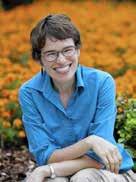
Choirmakes the shy kid brave. Choir makes the lonely kid included. Choir makes the anxious kid calm. Kids need choir.
I made that one up, but if you spend any time at all on social media, you’ve surely seen sentiments like it in meme form, posted on choral-director pages and shared approvingly by hundreds of conductors and music teachers.
Sorry. I’m not one of them.
And it’s not because these sentiments don’t reflect most of my own experiences in choruses growing up. I did, indeed, find confidence and passion and purpose in a series of rehearsal rooms, from the Saturdaymorning children’s chorus I joined at age six to the collegiate ensembles that cemented, once and for all, that conducting was what I wanted to spend my life doing.
Most of us in the profession probably felt that way, which is why we’re in the profession; that’s called selection bias, and it’s as misleading as it is satisfying. By and large, the people who like and share these posts are the ones who thrived in choir—the ones who matched pitch without strife, the ones who heard our own cultural experiences reflected in the music we sang, the ones who weren’t embarrassed or mistreated by choral directors.
Perhaps there’s a whole corner of social media where P.E. teachers share glowing memes about how field hockey practice and dodgeball help kids thrive and find their best selves. Personally, field hockey practice gave me bruises, dodgeball made me cry, and gym class never made me feel anything but scrawny and uncoordinated and alone—so I’d recoil in remembered trauma if I saw a meme like that, and it would be infinitely worse if I’d ever been the victim of abuse at the hands of a coach.
And especially now, especially in the midst of a years-long profession-wide awakening to the ways in which the music world has (inadvertently or deliberately) excluded and divided, I can’t help
wondering how many people have the same reaction when we post glowingly about the universal goodness of choir.
I’veirritated or puzzled more than a few people by saying this over the last year or so when one of these memes was making the rounds. So you don’t think music is important?? they’ve demanded. Why can’t you understand that we need to promote music education in a time when so many districts are cutting funding for the arts?
Of course I do. Of course we do. But let’s do it honestly.
As soon as we announce to the world that our choral rooms are, by definition, places of safety and inclusiveness, we also announce that we’re not open to debate on that topic. As soon as we post to our friends that every child feels included and welcomed in choir, we signal that we don’t particularly want to hear from the ones who weren’t, or aren’t. When we tell the world that choral music is an automatic equalizer, we ignore the careful work of listening, questioning, and evolving that actually makes it so.
The number-one factor that makes any classroom a safe and welcoming space is that we don’t assume it’s a safe and welcoming space. Each singer’s experience is different, and an authentically inclusive community isn’t achieved through proclamation; it’s created every day.
Instead of declaring choir a refuge for all, let’s ask our singers what would make it feel like one to them. Instead of boasting that the music room is a uniquely special place, let’s learn from our students and colleagues how we can make it so. Instead of platitudes, let’s have thoughtful, honest, difficult, important conversations about what our repertoire selections, rehearsal practices, and language choices say to the people who entrust us with their time and their voices.
Instead of memes about what the choral room already is, let’s make commitments to what we believe it can be.
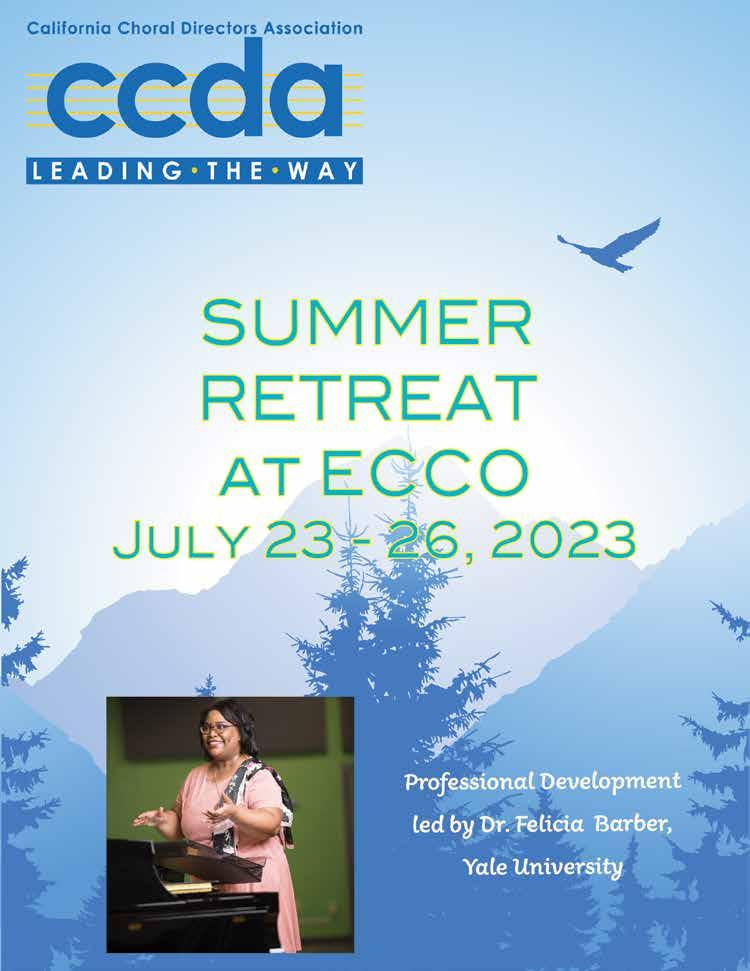
 BY JENNIFER
BY JENNIFER

I write here to acknowledge my responsibility to help to build a more respectful choral experience for my singers, and to stop being a passive bystander to historic problems that continue on in our music.1 —Stephen Sieck

“Should a predominantly white choir perform African-American Spirituals?” This was the question raised by one of my graduate choral conducting colleagues one afternoon at Michigan State University. We may have been avoiding homework or possibly putting off score studying—graduate students never do this—in the midst of a full day of choir rehearsals, and in the discussion that ensued, we talked about the historical implications of slavery, the continued perpetuation of minstrel songs in choral repertoire (I’m looking at you, “Camptown Races”), the difference between allyship and performative wokeness, and even the possibility of studying music but never performing it on stage.
One colleague asked if it was OK to perform music that does not speak to your own lived experience. Another asked if there was any way to fully understand someone else’s culture and identity regardless. We did not find definitive answers, but we did find common ground. Context, thoughtful programming, and finding ways to honor and respect the culture came up again and again. In the end, I remember it as a beautiful moment in which we were privileged enough to think, consider, reflect, hold space with each other even when we disagreed, and find common ground whenever possible.
The inspiration for this topic arose from my growing uneasiness with how “traditional” music programs often harm students of color, and an interest in expanding the types of music experienced by students in the ensembles I direct. Before attempting to deconstruct the way we traditionally teach, we must first ask ourselves What is it that we ultimately value? What do we hope students will experience in our choral ensembles that is different from their other courses? I am interested in providing a curriculum for students that is inclusive, diverse, and rooted in equity, and that forces me to reflect on how my own classes and ensembles have come far, far short of this goal—and to consider changing my future classrooms and ensembles to better align with these values.
The multicultural music industry has become an increasingly powerful and lucrative business in the 20th and 21st centuries. The multicultural tab on J.W. Pepper’s website yields hundreds of results, most of the
music having only been very recently published. Deborah Bradley addresses this phenomenon in her article “Singing in the Dark.” Bradley argues that the rise in multicultural music is linked to cutbacks in education and especially to public school music programs. Bradley says:
Does the current interest in multicultural music result from a desire to “spice up” our programming with music of a more “exotic” nature? When we choose to deliver a smorgasbord of musical diversity, rather than carefully considered programs of cultural concentrations that allow for deeper learning and understanding, we continue to consume the Other under the euphemism of providing “broad experience.” At the same time, we allow both our students and our audiences to invent their own versions of Otherness, thus perpetuating stereotypes, misinformation, mistrust, racism.2
Bradley argues that sometimes choral conductors, who are strained for time to prepare for performances, tend to rely on “invented Otherness” to provide contextualization for multicultural music. These exotic images of invented Otherness go on to perpetuate a system where the music of under-represented cultures “…is ours to use for our own entertainment and profit”3—in essence, reinscribing and perpetuating white colonialism on our concert stages in the modern era.
George Dei further argues that multicultural education is often a guise for tokenism.4 Dei writes, “It is not enough to add a few cultural artifacts or posters to the classroom and expect them to be the framework upon which marginalized students can build a sense of identity and inclusion.”5 The problem with a multicultural musical curriculum is that educators unknowingly reinforce Eurocentric systems of valuing and devaluing music. Juliet Hess, assistant professor of music education from Michigan State University and a fierce advocate for activism in music, describes tokenism as an approach that reduces the student experience with a culture to a “single experience” that often leads to a trivialization of the music.6 Multiculturalism begins with the good intention of “celebrating diversity,” but in reality, it tokenizes the cultures that we are attempting to recognize and honor.
Simply adding a piece by a female composer on our concert program or including an example of a Black composer in our music theory textbooks is not enough. We pat ourselves on our backs for diversifying the classroom or choral ensemble but do nothing about the lens through which we prioritize certain types of music over others. Continuing to view the music of non-Eurocentric composers through the lens of Eurocentricity does not provide answers to our problem. The solution lies with diversifying our repertoire but also the music theory behind the music. We have to dismantle the racialized structures that have systematically privileged music by
white male composers and systemically left most others by the wayside.
Centricity is the viewpoint by which students relate to various cultural perspectives taught in the classroom. According to George Dei, a multicentric education attempts to “center the lived experiences of a diverse student body as a starting point for education.”7 For most students in North America, Eurocentricity is the lens that shapes curriculum in the classroom. The problem with Eurocentricity is not that European knowledges being taught in our schools is inherently bad, but that “it is presented as the only valid knowledge form through the constant devaluation and delegitimization of other forms of ideas”8—that it is, broadly speaking, the only centricity provided to our students in our classrooms. Historically, North American schools have left no room for other viewpoints, alternative ways of knowing, or other lived experiences to be taught in the classroom.
A multicentric framework is student-oriented, it provides students with a “multiplicity of perspectives,”9 it deprioritizes Eurocentric knowledges, it is intersectional, and it must uncompromisingly assert that all cultures have impacted history and society as a whole. A true attempt at a multicentric curriculum would first involve centering the cultural perspectives of the students in the classroom and integrating those perspectives into the curriculum. Dei argues that multicentrism is predicated upon the idea of “the marginalized moving from the margins to the centre, and not simply being grafted into the existing order.”10
Multicentrism is fundamentally student-centered and student-oriented. The authors of Removing the Margins: The Challenges and Possibilities of Inclusive Schooling argue that teachers should search for ways to provide critical knowledge necessary for students to address modern-day challenges. They argue that educators need to decenter Eurocentric knowledge and provide space in classrooms for students to learn about “alternative ways of knowing.”11 They continue that true multicentric education must be intersectional, including race, gender, class, sexual orientation, religious identity, ability, and all other aspects of identity. Lastly, a multicentric education asserts that “all humans have contributed to world development and the flow of knowledge and information, and that most human achievements are the result of mutually interactive, international effort.”12
With these thoughts about multiculturalism and
multicentrism in mind, here are some proposed guidelines for incorporating a multicentric choral curriculum into the classroom or the choral rehearsal. This list of guidelines is by no means complete, and should be used as a starting point when considering this type of curriculum.
First, most of us, if we did our schooling in North America, received almost exclusive training in Eurocentric musical traditions. We analyzed J.S. Bach chorales in our theory classes and listened to Josquin des Prez in our music history courses. We spent hundreds of hours in private lessons on vocal techniques that were developed in a very small part of Italy in the sixteenth and seventeenth centuries, we studied and performed Beethoven, Mozart, and Handel in our choral ensembles, and we were often required to attend classical musical performances that were heavily steeped in Eurocentricity. Most of us were required to audition for our college-level music education teacher training programs with initial music theory exams (either aural, written, or both) as well as the requirement to sing repertoire from the classical vocal repertoire. Most of the time, these vocal auditions required us to perform at least one song in Italian, German, or French.
Audition requirements alone remind us that a classical music program’s foundation is built on the idea that Eurocentric music is the chief type of music worth studying and performing. Some might even argue that the adjudicators of these auditions were listening for “whiteness.” As students or as professionals, we may have attempted to educate ourselves in non-Eurocentric music traditions; however, often the studying of these musics occurs in less-structured ways than our formal Eurocentric studies. As choral educators, when it comes to musics of other cultures, we are most likely beginning the race from well behind the starting line.
Second, acknowledge that your identity and privilege have played a part in your ability to be successful in this career path. My own growth as a teacher significantly changed once I started recognizing and reflecting on my privilege: My parents always had money to pay for private music lessons; the vocal music I sang in private lessons and choral ensembles reflected my sexual orientation; I understood how to present myself and behave in a music school audition; I never had to worry whether I’d gotten a job because of affirmative action. The opportunities afforded to me were endless and undoubtedly allowed me to succeed in my chosen career path. The more I have recognized my own privilege, the more I have seen how the traditional music classroom has created roadblocks and hurdles for underprivileged students to overcome or else be left behind.
Is singing music from other cultures of value to you as a pedagogue? Why or why not? It is imperative that we think critically about the why behind our curricular decisions in the classroom. I have come to the conclusion that I would like to broaden my approach to programming, but each choral educator must make that decision for themselves.
Do you believe that other cultures have instinctual musical knowledges that may or may not be the same as the values that Eurocentric music holds? Do you believe that the music on your program should be representative of the diversity that you see in the students in your ensemble? Do you believe that all world cultures have impacted and affected music? Answering these questions will undoubtedly help you to actively shape a multicentric curriculum that is of value to you, rather than be a spectator to historical problems that still persist in the choral classroom.
Besides my belief that students in my ensembles should study music from non-Eurocentric cultures, I also believe, as I think most of us do, that students should study high-quality music first and foremost. Consider how your past Eurocentric musical training may bias your opinion, and make sure you are spending enough time with a piece of music before setting it in the “no” pile. On the other hand, we have all seen arrangements that seem to “parody” or perpetuate a stereotype about a certain culture or ethnic group. We have all programmed pieces on our concerts because they are highly rhythmic, they “sound cool,” or they make a great concert closer. In an effort to avoid the pitfalls of multiculturalism, we must have a clear and strong vision on how those non-Eurocentric pieces fit into our concert programs.
Consider the balance of types of musics your students will be exposed to or encouraged to study in your class. How are non-Eurocentric cultures represented on your concert programs? Are non-Eurocentric musics present on your concert programs? Is there at least an attempt at diversifying your repertoire list?
Furthermore, rather than programming a “one-off” non-Eurocentric piece, consider programming multiple pieces per concert that allow students an in-depth exploration of a particular culture, time period, or musical language. This way, students can make richer connections to the musical language and cultural context of a chosen culture’s choral music across a variety of time periods.
Remember that your rehearsal process with these less-familiar pieces will, and should, take longer than a piece from the Eurocentric canon. This is because you, most likely, have not had as much training in musics
from non-Eurocentric cultures. Do you have the time to delve into these less-familiar genres? Plan your time appropriately, and generously, to do your score study and research. Then allow your students more time in the rehearsal process to experience these non-Eurocentric musical styles through multiple contextualization activities leading up to the concert.

Plan to spend at least twice the amount of time in rehearsal with repertoire that you are less familiar with. For my doctoral recital I prepared, rehearsed, and conducted Haydn’s Missa Brevis in F Major. When I decided to program this piece on my doctoral recital, I already knew some basic biographical information about Haydn, common Classical-era musical structures like sonata form, and pronunciation for Latin diction. I understood the context of a Mass setting in the Catholic Church, how to teach and model a classical bel canto vocal production, and more. When I pulled out the score for the first time I already was fifty yards ahead of the starting line due to a rigorous and highly focused musical training from my schooling.
Now consider a Ukrainian folk song arranged by Mariana Sadovska and Kitka Women’s Vocal Ensemble, “Oj, u horodi.” In preparing this piece, I had to learn and be able to coach a different vocal production, learn how to pronounce the Ukrainian text, and understand and make decisions on stylistically appropriate embellishments. I spent extra time learning about the history of Ukrainian women participating in fortune-telling and divination. The study of this piece also occurred, accidentally, at the same time that Russia invaded Ukraine. So when Vladimir Putin argued that Ukraine was really just a Russian territory, this piece helped to teach the singers that Ukraine was its own nation with a cultural identity that was entirely separate from Russia. It simply takes a lot longer for conductors to prepare music from unfamiliar cultures, so we should anticipate that and integrate it into our preparatory work.
Find local experts. For example, if you are singing a piece intended for use in the Jewish Sacred Service (consider Ernest Bloch’s “Silent Devotion and Response”), find someone who is fluent in Hebrew to come in and coach the language. Even better, find a content area expert who can speak about how this piece would fit into the broader context of Judaism and be able to speak on the effect the Holocaust had on early 21st-century choral composers. How long do we spend on specific pronunciations with songs in English? I have spent countless rehearsal time coaching students to avoid chewing an“r” in the word “linger” or matching our vowels on the word “love.” In choral music the message and meaning of the piece is integral to our art form, and
when we don’t do our due diligence on simple things like pronunciation, everyone loses out on a more meaningful musical experience.
Lastly, if we want to be consulted on the music that we are knowledgeable in, we should be willing to reach out and find experts when we are performing music that we are less-familiar with. Make sure to compensate these experts in some way, either financially or through some sort of exchange of knowledge. Consulting these experts will ultimately enable us to perform these pieces with the highest level of respect and honor.
Are you white? Are your students predominantly white? Are you choosing to sing a piece of music that is from a culture that was historically oppressed due to colonialism or racism? If you answered yes to any of the above questions, you should recognize and discuss that power relationship with your ensemble. Answering yes does not mean you cannot or should not perform this music. It may in some cases, but that is a question you as the director must have a firm grasp of before the downbeat of the first rehearsal. Answering yes to the above questions does, however, mean that you hold an enormous responsibility in navigating this music respectfully and responsibly.
Consider too how the predominantly white music publishing industry plays into the power imbalance in commodifying repertoire from historically oppressed communities. In “Singing in the Dark,” Deborah Bradley explores how copyright laws have traditionally harmed cultures that have an “oral-aural” tradition. Consider “Siyahamba,” a Zulu folk song traditionally passed down aurally. When Anders Nyberg published a transcription of this tune in his collection of South African folk songs, the Zulu people could not (because it would be impossible) name an individual composer as the original creator of the tune. Therefore, “Siyahamba” became the intellectual property of Walton Music. Arrangers who wished to arrange this tune14 had to secure copyright permission from Walton Music.15 At no point throughout this chain of commercialization were the Zulu consulted, asked permission, or compensated for use of their song. In effect, predominantly white- owned publishing corporations are reinscribing colonialism by using and profiting off of the music from former European colonies.
Ask yourself with each new piece of repertoire, who holds the power? Is it the publishing company? Is it the composer? Is it the people that created this folk tune? The answers might be more complicated than you expect.
The act of contextualizing, or sometimes problematizing, music in the choral classroom should be fundamentally
and centrally rooted in respect. Stephen Sieck writes, “When we do the kind of preparatory work that honors different musical cultures, we create an environment where all people are respected.”16 If we respect the music, then we will do everything we can to give our singers the deepest understanding of these musics. If we respect our students, then we will encourage them to “step into the shoes” of these non-Eurocentric cultures through meaningful, exciting, and masterful repertoire.
If we decide we must problematize a piece, consider a trauma-informed approach when dealing with difficult topics. William Sauerland defines this type of pedagogy in his recent 2021 Choral Journal article: “…trauma-informed pedagogy (TIP), also known as trauma-informed practice, trauma-sensitive teaching, and trauma-informed positive education, does not seek to help students recover from past traumatic events, but underscores the role trauma might play in the lives of students.”17 Consider telling students ahead of time about discussions you plan to hold, and allow students a safe opt-out option if they decide they cannot participate.
Let us examine Jake Runestad’s piece “Please Stay,” which deals extensively with the topic of suicide. Most teachers understand that undertaking this piece would include many conversations and discussions with their singers about suicide and mental health. Directors should consider telling singers ahead of time so that they can adequately prepare themselves. The same could be said of pieces like “And They Lynched Him On A Tree” by William Grant Still. We should prepare our students when we are going to be discussing the horrific atrocities of slavery in a classroom setting and allow students to opt out of those discussions if they feel they need to.
Conclusion
One of my goals when I first started teaching was to create musical opportunities for my students to engage with music from other cultures. I write this knowing full well that what I did with my previous ensembles was, at best, bland and uninformed multiculturalism, and at worst tokenism. I resonate with these thoughts from Stephen Sieck’s book Teaching with Respect:
While the motives of multicultural world music may be well-intentioned, I question whether our process has been as benign as we imagined it. As a White person singing choral music, I have the privilege of not being conscious about my race or ethnic identities. Since the overwhelming majority of repertoire I sing is written by people who look like me, I rarely think about identity I just sing…We have to acknowledge the problems in this and begin to do better.18
We can no longer be satisfied with well-intentioned
but ultimately problematic repertoire and curriculum choices. We need educators who can broaden their own perspectives and viewpoints through a multicentric musical framework that is inclusive of the diversity of the students in their classrooms and ensembles. Educators who allow for a multiplicity of musical perspectives, who honor and validate the cultures of the students in their classrooms, and who engage in a thoughtful and respectful studying of these musics will help to break down the oppressive structures that have historically excluded, marginalized, and alienated students of color. A multicentric framework in education serves to center the viewpoints of traditionally under-served and minority students in the classroom. This anti-racist educational framework also helps students to deal with the contradictions found in modern society and the moral ambiguities in a constantly shifting, globalized society.
1 Stephen Sieck, Teaching with Respect: Inclusive Pedagogy for Choral Directors (Milwaukee, Wisconsin: Hal Leonard, 2017), 110.
2 Deborah Bradley, “Singing in the Dark: Choral Music Education and the Other,” paper presented at Philosophy of Music Education Symposium V, Lake Forest College, Illinois, June 2003, 18-9.
3 Bradley, “Singing in the Dark,” 20-1.
4 George J. Sefa Dei et al., Removing the Margins: The Challenges and Possibilities of Inclusive Schooling (Toronto, ON: Canadian Scholars’ Press Inc., 2000), 238-9.
5 Dei et al., Removing the Margins, 245.
6 Juliet Hess, “Upping the ‘anti-‘: The value of an anti-racist theoretical framework in music education,” Action, Criticism & Theory for Music Education 14, no. 1 (April 2015): 81.

7 George J. Sefa Dei, Anti-racism education: Theory and Practice (Halifax, Nova Scotia: Fernwood Publishing, 1996), 82.
8 Dei, Anti-Racism Education, 82.
9 Sonia Nieto, “From Brown Heroes and Holidays to Assimilationist Agendas: Reconsidering the Critiques of Multicultural Education,” in Multicultural Education, Critical Pedagogy, and the Politics of Difference, ed. by Christine E. Sleeter and Peter McLaren (Albany: State University of New York Press, 1995), 197.
10 Dei, Anti-Racism Education, 82.
11 Dei et al., Removing the Margins, 237.
12 Molefi Kete Asante, “The Afrocentric Idea in Education,” The Journal of Negro Education 60, no. 2 (Spring 1991): 173.
13 As of February 27, 2023, there were 20 choral arrangements of “Siyahamba” for sale through JW Pepper.
14 The publisher is considered the original copyright owner in this case, not the transcriber. The copyright owner is granted the exclusive right “to prepare derivative works based upon the copyrighted work” as per the US Copyright Act (Title 17 of the United States Code) (the “Copyright Act”) at Section 106(2). Accessed February 26, 2022, https://www.copyright.gov/ title17/title17.pdf.
15 Sieck, Teaching with Respect: 106.
16 William Sauerland, “Sound Teaching: Trauma-Informed Pedagogy in Choir,” The Choral Journal 62, no. 3 (October 2021): 35. Accessed May 2, 2022. https://eds-p-ebscohost-com.proxy1. cl.msu.edu/eds/pdfviewer/pdfviewer?vid=5&sid=eafce823ca66-4b56-beb4-be54625d7405%40redis

17 Sieck, Teaching with Respect, 103.
JeNNIFER HEDER became the director of choral ensembles at Fresno City College in the fall of 2022. She holds degrees from Brigham Young University and a doctorate from Michigan State University.
Whatever your touring experience, interests, or goals, ACFEA Tour Consultants is dedicated to designing an exceptional tour just for you.
com
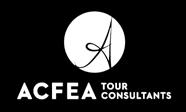
Wehope you were able to attend the 2023 All-State Honor Choir concert; the students’ incredible achievements are a testament to the expertise and dedication of you, their directors! We also thank everyone who made this year’s All-State Choirs possible: the regional audition hosts and judges, regional event chairs, chaperones, ensemble managers, guest conductors, and brilliant collaborative pianists. Lauren Diez, thank you for your meticulous work as chaperone/hotel coordinator. The junior high honor choir chaperones and manager (Harlee Balajadia, Miguel Chicas, Jenni Gaderlund, Andrew Lu, Emelynn Montoya, Jocelyne Ramirez, and Sammy Salvador) deserve an extra special shout-out for rolling with the punches and taking over rehearsals when their guest conductor’s flight was delayed multiple times! We are honored and humbled to have such an amazing team to make this experience a reality for students from all over the state.
We are delighted to announce that the CCDA board has approved the addition of a Junior High/9th Grade Treble All-State Honor Choir starting in 2024! CCDA’s Junior High/9th Grade All-State Honor Choir began in 2016 as an SATB ensemble. Over the past several years, the interest and participation have increased to a point where it is now possible to populate an additional
treble-voice honor choir to accommodate the large numbers of motivated and talented young choral musicians in grades 6–9 across the state. Starting in 2024, the SATB and SSAA Junior High/9th Grade honor choirs will be populated by ranking the soprano and alto audition scores above the cutoff and alternating placement in the mixed and treble choirs, while all tenor and bass audition scores above the cutoff will be placed in the mixed choir.
The 2024 All-State Honor Choirs will take place at CASMEC in Sacramento from February 1-3, 2024, with guest directors Ms. Mary Biddlecombe (Junior High School SATB), Dr. Brandon Williams (Junior High School SSAA), Dr. Elisa Dekaney (High School SSAA), Dr. Troy Robertson (High School TTBB), and Dr. Julie Yu (High School SATB). If you are a long-term planner, please also note that due to the availability of Sacramento’s convention center, CASMEC/All-State 2025 will take place in Sacramento from January 16-18, 2025.
Save the date for the 2023 Coastal and Central Region High School Honor Choirs: November 16-18, 2023! Please keep an eye on your email and the Honor Choir website (calcda.org/general-info) for more details on the 2023-2024 school year events, including audition information, by the end of this school year.






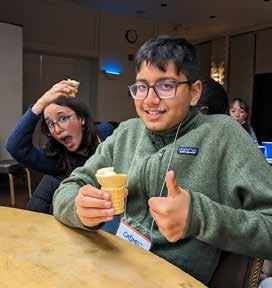
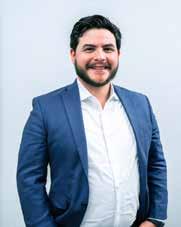
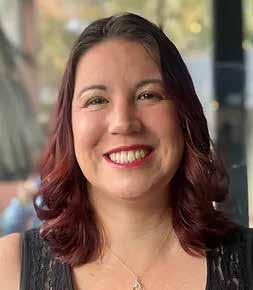


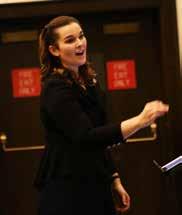

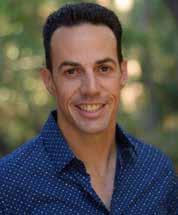
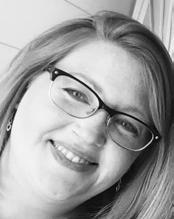



DEGREES OFFERED
Choral Music BM, MM, DMA Sacred Music MM, DMA
APPLICATION DEADLINE
DECEMBER 1, 2023
music.usc.edu/choral
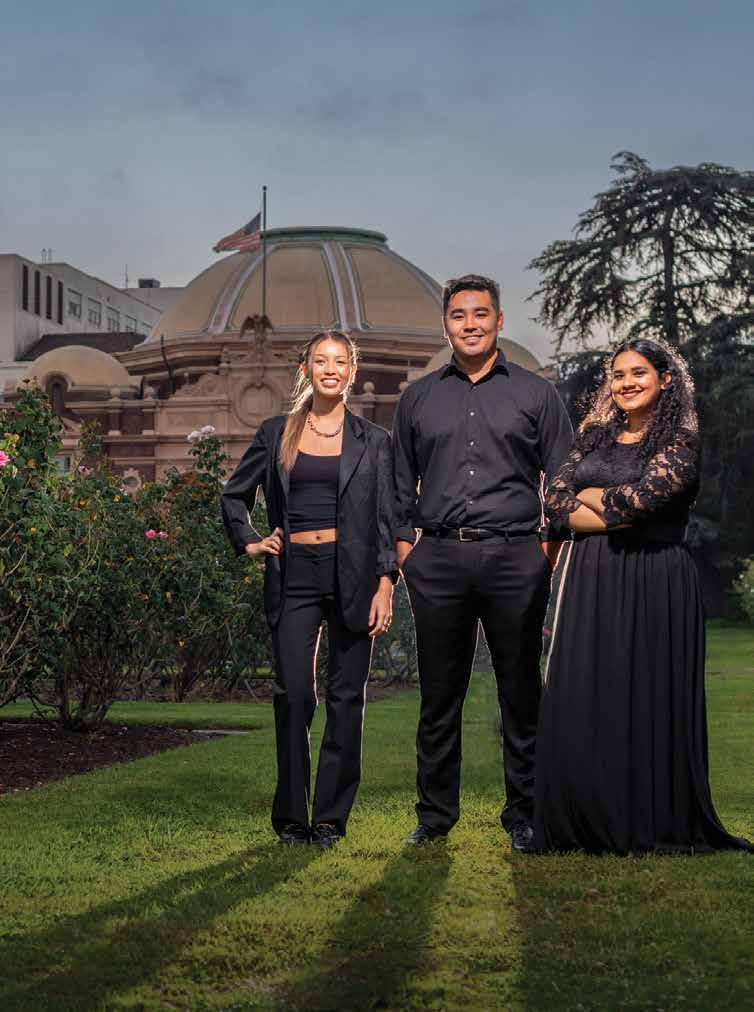






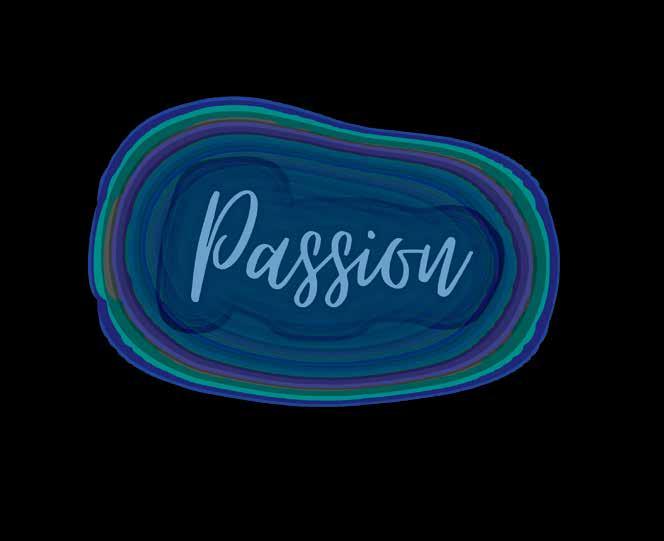

Clockwise from near right: Rabblerousers at CASMEC; singers from Notre Dame High School (San Jose) wait their turn at the Santa Clara University choral festival (photo courtesy Tina Paulson); members of the Mira Costa High School choirs (Santa Monica) during their tour of Prague, Vienna, and Salzburg (photo courtesy Kate Crellin); and some of the powerful women leading the charge for CCDA and ACDA Western Region (photo courtesy Julie Dana)! Turn the page for more!

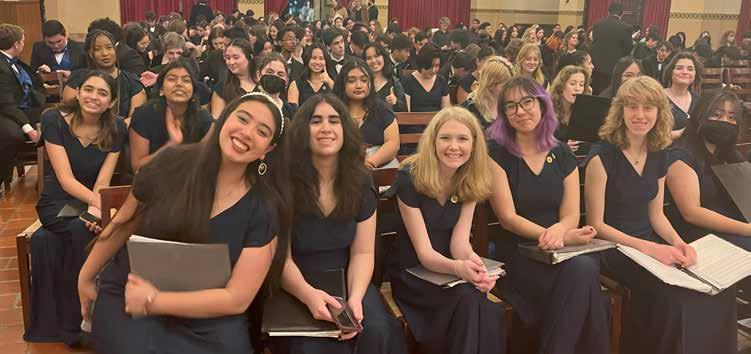
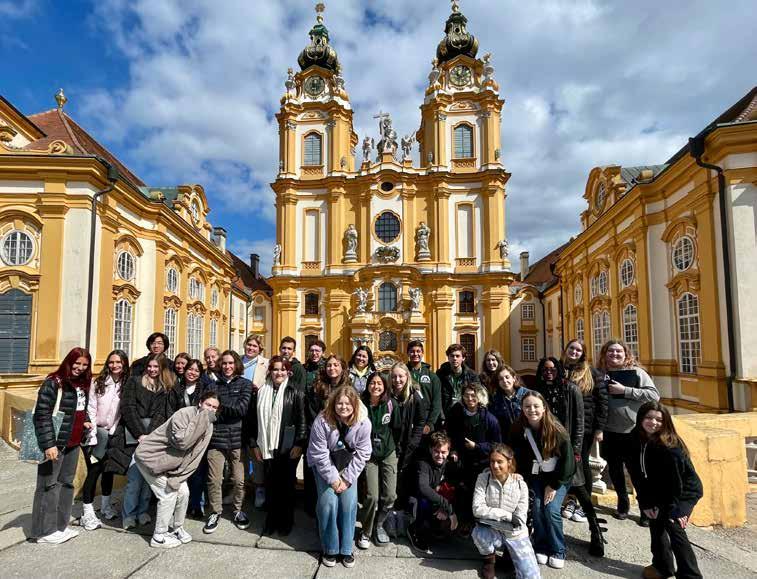
Clockwise from above: Singers from Granite Bay High School take part in the Capitol Section Honor Choir (photo courtesy Susanna Peeples); singers from Enterprise High School (Redding) enjoy the beach in Santa Monica during their spring break trip (photo courtesy Alissa Aune); and the Piedmont Easy Bat Children’s Choir performs in Joyce DiDonato’s EDEN tour in Berkeley (photo courtesy Keri Butkevich).
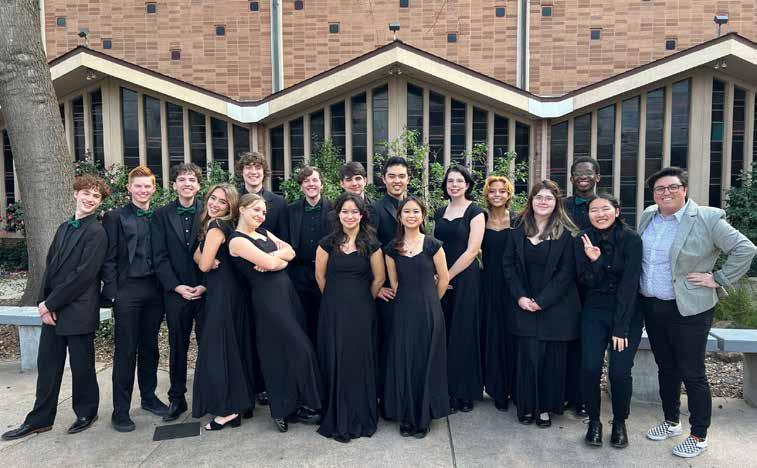

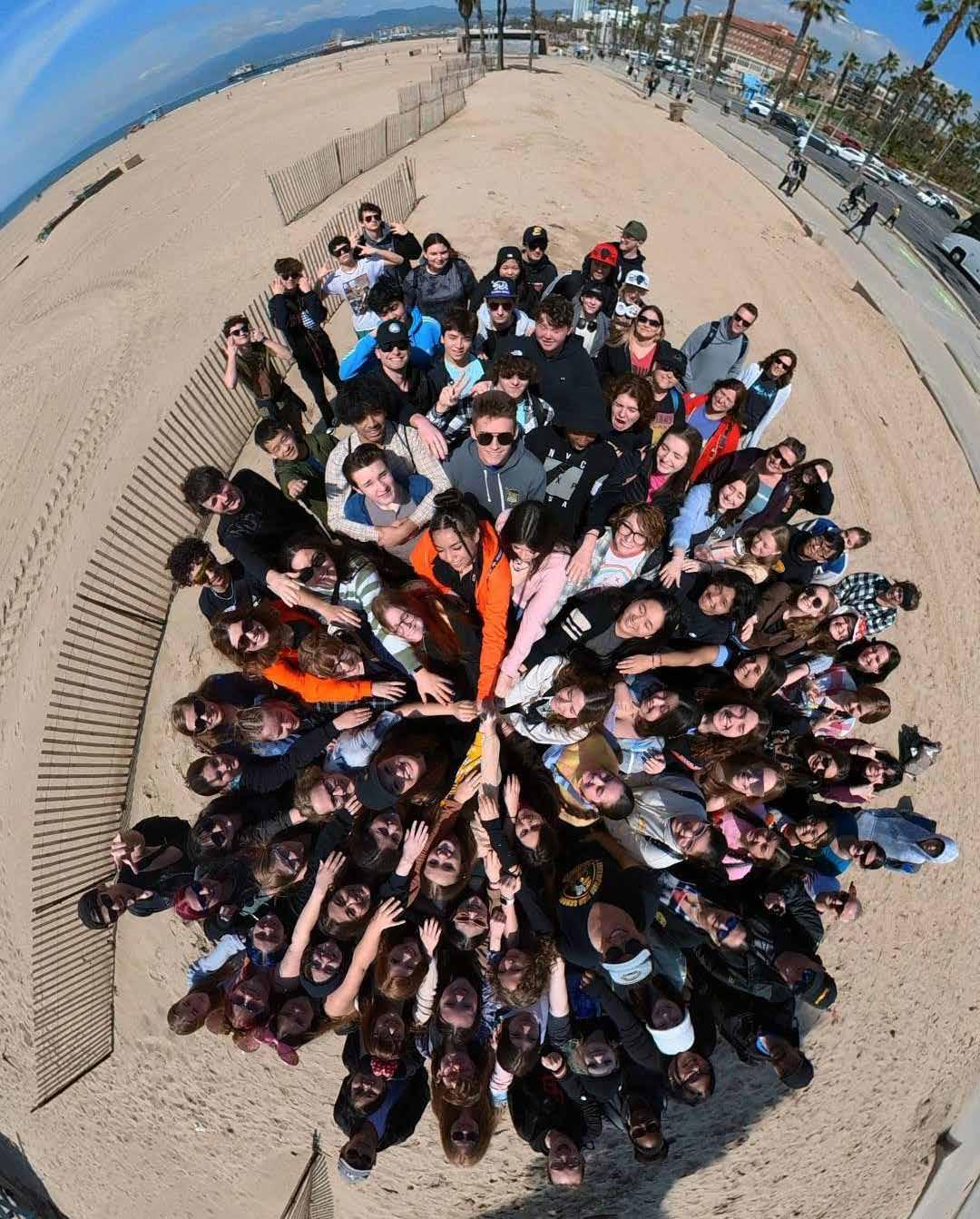

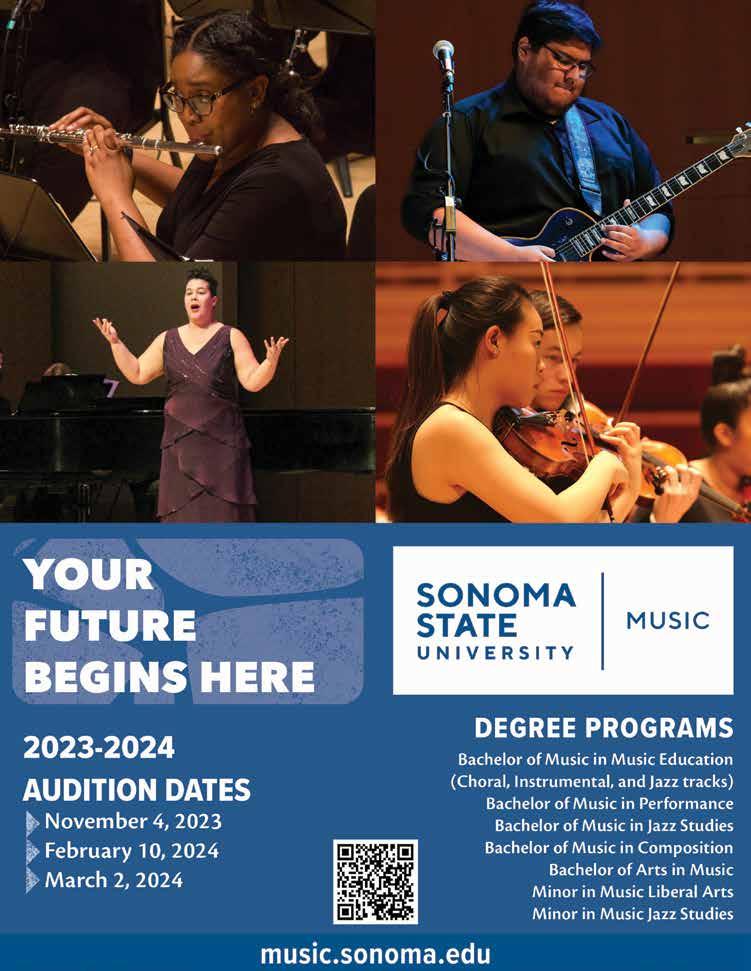
Congratulations to these CCDA Southern Region members who presented or performed at the CASMEC Conference: Joshua Palkki and Joni Prado (interest session presenters), and performing groups Ayala High School (Robert Davis), Mater Dei High School (Jodi Gould Reed) and San Juan Hills High School (Michael Ushino).
Interest session presenters at the ACDA National conference in Cincinnati, Ohio, included Cristian Grases, Saunder Choi, Zanaida Robles, Gene Peterson, Rob Dietz, and Stevie J. Hirner. The conference also included performances by Mt. San Antonio College (Bruce Rogers), CSULB’s Bob Cole Chamber Choir (Jonathan Talberg), the Hour of Power Choir (Irene Messoloras), Valencia High School (Christine TavaresMocha), and The Sterling Ensemble (Michelle Jensen). Iris Levine led the Music in Worship event, and Fernando Malvar-Ruiz served as conductor of the 2023 Elementary Honor Choir.
The Choral Consortium of San Diego (Carol Manifold, Executive Director) continued “Conversations with Conductors” series including Nicola Dedmon (Fullerton College) and Dr. Aaron Humble (California State San Marcos) discussing collegiate choral programs, Alex Benestelli (St James by-the-Sea Episcopal) and Elizabeth Virkler (Rancho Bernardo Community Presbyterian) discussing church
choral programs, and Charles Beale (San Diego Gay Men’s Chorus) and Benjamin Thiele-Long (Stellarum Chamber Choir) discussing community choirs.
The Challenger Middle School choir (Marielena Teng) had the incredible opportunity to perform alongside the internationally acclaimed mezzo-soprano Joyce DiDonato as part of her “Eden” world tour. This innovative project incorporates music, drama, and education to inspire hope and promote positive change. In addition to their performance, the students engaged in a series of workshops focused on climate change and related themes.
The Visual and Performing Arts Department (VAPA) of San Diego Unified School District presented a District Honor Choir Concert featuring three choirs of 180+ students in grades 4-12, from 35 schools at Lincoln High School: Debut Choir (grade 4-6) with Emma Schopler, Treble Choir with Dr. Yewon Lee, and Tenor-Bass Choir with Robert Meffe.
The Granite Bay Choir, led by Susanna Peeples, had the honor of performing in Honolulu as part of the 2023 Pacific Basin Music Festival this March. She says that the kids learned a lot about themselves and Hawaiian culture through their exchange with the Hawaiian Youth Opera Chorus, even learning a new song and hula!
Alison Skinner and the Davis Chorale presented a program exploring three very different visions of the divine: Duruflé’s Requiem, for
organ and choir, based on the original Gregorian chant; Britten’s Rejoice in the Lamb, a setting of sacred ecstatic poetry praising God in all forms; and Reena Esmail’s When the Violin, for cello and choir, a setting of a Hafiz poem, with music inspired by Hindustani tradition.
Valerie Ayabe, the Choral Director at Boulder Creek School in Redding, reports that the BC Bears Middle School Choir and the Sound Bearriers have performed for their veterans at Boulder Creek and at the Northern California Veterans’ Cemetery for Veterans’ Day, as well as at the Spring Choral Festival in Redding on Tuesday, March 21, 2023.
Dr. Donald Kendrick and the Sacramento Choral Society and Orchestra, as well as the Sacramento Children’s Choir, presented Carl Orff’s Carmina Burana, along with a new work by Eriks Ešenvalds, and the Dvorak Carnival Overture, on May 13 in Sacramento’s SAFE Credit Union Performing Arts Center.
The Sacramento State University University Chorale (Andrew Kreckmann) performed Palestrina’s Pope Marcellus Mass at the Cathedral of the Blessed Sacrament in downtown Sacramento. On May 6th they joined the choirs and orchestra at Fremont Presbyterian for their 1st Annual Scholarship Concert, benefitting vocal and orchestral students. They performed Handel’s Dixit Dominus and Poulenc’s Gloria.
Congratulations to iSing Silicon Valley and conductor Jennah Delp Somers. They performed beautifully
at the 2023 ACDA National Conference in Cincinnati, and featured a newly commissioned work from Bay Area native, Kenyon Duncan. World-famous soprano Estelí Gomez joined the ensemble for the premiere as well.
On May 26, the five-member vocal ensemble Affeccyon will perform “Preserving the Past: Sarum polyphony in Dr. Gyffard’s part books” in Stanford University’s Memorial Church. Directed by Ph.D. student Daniel Koplitz, the performance project foregrounds pre-Reformation motets and Mass movements by anonymous or lesser-known Tudor composers and will culminate in the works’ first-ever digital recording.
Santa Clara University’s High School Choral Festival made its triumphant return at the end of January. Over 225 high school students from 8 different schools participated. Many thanks to Dr. Scot Hanna-Weir and Tina Paulson for coordinating the event.
Vivace Youth Chorus is celebrating their 20th year with an anniversary concert in June, and will present worldpremiere commissions from Andrea Ramsey and Vivace alum Kenyon Duncan. The event will feature an alumni choir conducted by Artistic Director Emerita Peggy Spool, and will include all six of Vivace’s ensembles, conducted by Artistic Director Kristina Nakagawa and Associate Conductors Katerine Carmona Arbeláez, Jay Jordana, and Albert Mabeza.
The San Jose State University Choraliers celebrate their 75th anniversary in May, with alumni joining current singers for a concert conducted by Drs. Charlene Archibeque, Jeffrey Benson, and Corie Brown.
Analy High School Chamber Singers, under the direction of Carl Oser, performed with Bobby McFerrin and MOTION for two standing-room only high school assemblies and two sold-out shows at the Sebastopol Community Cultural Center. Carl himself got to do an extended improvisation with Mr. McFerrin!
Piedmont East Bay Children’s Choir premiered Robin Estrada’s “Nag Iibang Hangin (Changing Winds)” and PEBCC’s Artistic Director Eric Tuan’s “In the Desert” in April.
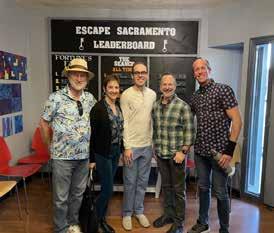
Sing Napa Valley presented Carmina Burana in April, conducted by Jan Lanterman (past secretary for California ACDA) and accompanied by past-California ACDA President and 2022 Howard Swan award winner Travis Rogers. Jan is also celebrating 50 years as the choir director at Napa Methodist Church. Congratulations, Jan!
On March 31, the Cuesta College choirs (John Knutson, Director) performed “The French Connection,” a preview of their tour to France. Their all-American musical selections were specially selected to connect the music to French tastes and architecture.
The Canzona Women’s Ensemble (Cricket Handler and Jill Andersen, directors) of San Luis Obispo presented “Singing Her Story,” an intimate concert of heartfelt storytelling and song, on March 12. Featuring music selections inspired by vignettes from the family heritage of Canzona singers, the program showcased a diverse repertoire.
The Cal Poly Choirs, under the direction of Dr. Scott Glysson, performed the Requiems of Mozart and Herbert Howells at Mission San Luis Obispo in March.
Cal Poly Cantabile (formerly Women’s Chorus) presented a concert of works by women composers and poets, including two world premieres by Jocelyn Hagen and Meredith Brammeier at Lincoln Center’s Avery Fisher Hall on March 25.
Everyone felt the joy of post-Covid excitement as the Fresno area filled with musicians for the CASMEC Conference in February. Central Region’s own Dr. Ángel M. Vázquez-Ramos (CSU Bakersfield) served as CCDA’s CASMEC coordinator, and the Conference was a great success. Matthew Hanne (CSUB) gave a session on “Inspiring Improvisation: Embracing Chance in the Choral Rehearsal” and Polly Vasché (Thomas Downey High School, Modesto, retired) presented “Singing is Listening: Engaging Mind and Ear in the Choral Rehearsal.” Dr. Cari Earnhart (CSU Fresno) also facilitated the honor choirs rehearsal spaces at Fresno State.
Days after the close of CASMEC, many Central Region choral directors flew across the country to Cincinnati for the National ACDA Conference. Dr. Daniel Afonso (CSU Stanislaus) was selected to write the commissioned composition for the 2023 National Elementary honor choir. His piece, “Marcha Pezinho,” is an arrangement of two Brazilian folksongs. Students of Michael Gutierrez (Firebaugh HS) and Marc McGhee (Lemoore HS) performed with the ACDA National Honor Choir in Cincinnati. Dr. Cari Earnhart (CSU Fresno) co-chaired the Indigenous Peoples Immersion choir with Tracey Gree-Boothby, and Dr. Jennifer Heder (Fresno City College) performed with the professional women’s ensemble Miribai. Congratulations to all!
The CSU Bakersfield Chamber Singers, Bakersfield Master Chorale, and combined Bakersfield College Choirs, conducted by Dr. Ángel M. Vázquez-Ramos and Dr. Jennifer Garrett (Bakersfield College) came together with the Bakersfield Symphony Orchestra in March to present the Verdi Requiem in Mechanics Bank. Dr. Vázquez-Ramos also received the Kern County Collegiate Conductor of the Year Award.
Several Central Region choral directors conducted various honor choirs including Amanda Isaac (Bakersfield HS) for the Kern County Junior High Middle School Honor Choir, Polly Vasché for the San Joaquin County Middle School Honor Choir, and Dr. Ron Kean (Bakersfield College, retired) for the Tulare Kings County High School Honor Choir.
In the Kern High School District, Patrick Burzlaff (Centennial High School) brought together an 80-voice alumni choir to celebrate the 30th anniversary of Centennial High School. Centennial’s first choir director, Greg Lapp (University HS, Irvine, retired) joined the rehearsals and conducted a few songs at the concert also. It was a memorable evening for all.
At LMU Music, we offer a personalized approach to music education, housed in stateof-the-art facilities in the second-largest U.S. music market. Offering concentrations in Contemporary Styles and Practices, Instrumental Studies, Vocal Studies, Theory/ Composition, Musicology, Ethnomusicology, and Conducting,
Thanks to our Regional Representatives (Andrew Kreckmann, Northern; Kristina Nakagawa, Bay Area; Jennifer Garrett, Central; Scott Glysson, Central Coast; Tina Glander Peterson, Southern; and Yewon Lee, Far South) for collecting and sharing news from their areas! Send your news to your regional representative if you’d like to be included in a future issue. cfa.lmu.edu/music
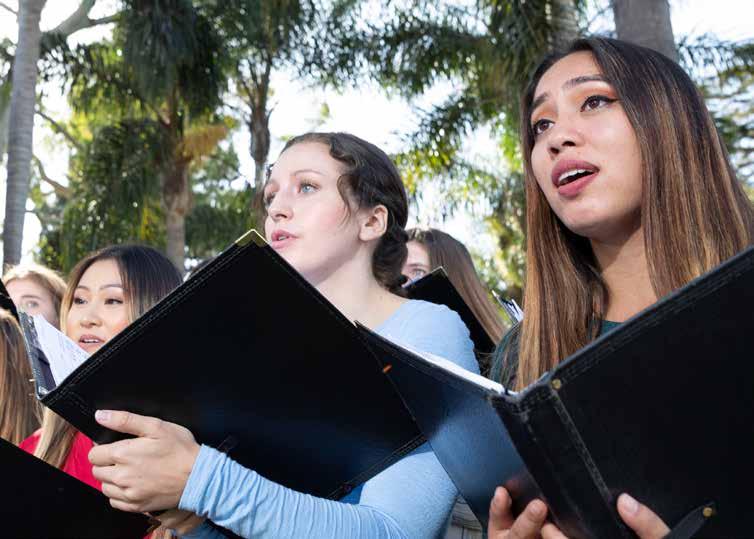

This list includes donations made between MARCH 20, 2022, and APRIL 20, 2023. Donations made after that time will be acknowledged in the next Cantate and may be found on our website. Thank you for your support!
President’s Circle Diamond ($1000 and higher)
Dr. William D. Hall, in thanks to my students and friends for the many years of music and memories
David Masone, in honor of husband, Dr. William Hall
Melanie Nelson, in honor of Dr. William D. Hall
Lori Marie Rios and Bryan D. Walker*, in honor of Shirley Nute, Don Brinegar, and Bruce Mayhall-Rastrelli
Sarah McGah and Ken Roehrs, in thanks for 40+ years of choral excellence with the William Hall Chorale Dr. Jonathan Talberg*, in honor of Dr. William Hall Anonymous
President’s Circle Platinum ($500-$999)
Dr. Daniel Afonso Jr.*, in honor of Bill Hatcher
Alvin and Juanita Brightbill
Gregory Norton, in honor of Dr. William Hall
Gene Peterson
The Sorber Family*, in honor of Dr. Anna Hamre Burt and Polly Vasché*
President’s Circle Gold ($300-$499)
Kathryn J. Carpenter, in honor of Maestro Dr. William Hall
Mike and Julie Dana, in honor of my students, now colleagues
Lou De La Rosa, in memory of Jim Heiner
Brandon Harris
Yewon and Dan Lee
Dr. Iris S. Levine*
Duane and Linda Lovaas*
Dr. Christopher and Tina Peterson*
Zanaida Robles
President’s Circle Silver ($100-$299)
Florence Agcawili
Alissa Aune
Jenny Bent
Katheryn Bravante
Patrick Burzlaff
Laura Holmes Cea
Lauren Diez
Michael DiGiacinto
Mary Hamilton
Wendy Hauk Kaiser
Dr. Ron Kean*, in memory of Dr. Lynn Bielefelt
Stacey Y. Kikkawa
Albert Mabeza
MaryClare Martin * in honor of Lena and Art Babin and Signe Boyer
Susie Martone
Gregg and Sandra Laughlin, in memory of Monica Lehman
Jeff Morton
Antone Rodich*
Dr. Ángel M. Vázquez-Ramos and Jody
R. Vázquez*
Royce and Darlene Wise, in honor of Dr. William Hall
William Zinn *
Sponsor ($50-$99)
Heather Bishop
Jane Carter
Deborah Divine
Jennifer Gaderlund
Andrew Hathaway
Anastasia Legatos, in honor of Dr. Ginger Colla
Robert MacNeil
Kim Nason*, in honor of Rob Istad and Chris Peterson
Molly Peters, in honor of Lori Marie Rios
Joshua W. Small and Gerardo D. Ramirez
Carolyn Teraoka-Brady*
Jennifer Tibben and Sharon Hickox
Supporter (up to $50)
Anthony and Cassie Arnold
Rhonda Lynn and Brian D. Bauer
Jeffrey Benson*
Judy Bowers
Corie Brown
Kellori Dower*
Brandon Elliot
Angelina Fitzhugh
Alan Garcia
Dr. Jennifer Garrett
Scott Glysson
Jennifer Hansen Heder
Julianna Jerome-Drerup, in honor of Dr. William D. Hall
Andrew Kreckmann, Sacramento State
Arlie Langager*, in memory of Lynn Bielefelt
LaNell Martin
Emelynn Montoya
Kristina and Ryan Nakagawa* in honor of Lois Caran, Joe Huszti, and Charlene Archibeque
Dennis Nasitka, in honor of Dr. William D. Hall
Samantha T. Nickel
Joshua Palkki
Jason Pano, in honor of Lou De La Rosa, Robert Istad, and Christopher Peterson
Anabel Pauline
Andreas Preponis
Patricia Prunty, in honor of Dr. William Hall
Jackie Reeff
Christiane Rohayem
Eliza Rubenstein*
Laryssa Sadoway
David García Saldaña
Anna Thoreson
Anonymous, in honor of Travis Rogers
Dr. William Hall
Florence Agcawili
Jenny Bent
Pamela Bertin
Katheryn Bravante
Alvin and Juanita Brightbill
Patrick Burzlaff
Kathryn J. Carpenter
Jane Carter
Laura Holmes Cea
Michael DiGiacinto
Dr. William D. Hall
Mary Hamilton
Catherine Stoltz Hammon
Andrew Hathaway
Julianna Jerome-Drerup
Wendy Hauk Kaiser
Dr. Ron Kean
Stacey Y. Kikkawa
Yewon and Dan Lee
Robert MacNeil
Susie Martone
David Masone
Gregg and Sandra Laughlin
Jeff Morton
Dennis Nasitka
Melanie Nelson
Gregory Norton
Molly Peters
Gene Peterson
Dr. Christopher and Tina Peterson
Patricia Prunty
Jackie Reeff
Sara McGah and Ken Roehrs
Dr. Jonathan Talberg
Anna Thoreson
Burt and Polly Vasché
Royce and Darlene Wise
William Zinn
Anonymous
* Founder’s Circle
ANtHoNy E. ARNolD has been teaching music for 27 years he started his teaching career in elmhurst, illinois at timothy christian schools

from 1995-1997 after graduating cum laude with a degree in music
education from azusa Pacific university. two years later, he settled in san Jose, where he taught five years at valley christian schools his choirs at miller middle school in the cuPertino union school district have Performed for the acda national conference, the acda western regional conference, ccda state conference, davis symPhony hall, the world choir games in cincinnati, oh, and carnegie hall, twice
Greetings and salutations colleagues as we gear towards the end of our school years. It was so good to see some of you again this year at CASMEC. In case you were unable to join us, here are my top five song choices to consider for end of year or next year’s programming:
English folk song, arr. lori-annE Dolloff
Manx Lullaby
Unison with piano and C instrument
Boosey & Hawkes
An absolutely beautiful song to start of the school year. Indigenous to the Isle of Man off the coast of England, this folk song brings attention to the birds of the area as they play a vital role in the Celtic culture of the land. The Manx Gaelic used in this song is a perfect introduction to your students of the origins of the English language, which can provide you opportunities to embrace the rich music and cultures of the English islands.
Brazilian folk song, arr. BraD grEEn Cirandeiro
Two-part treble and piano
Henry Leck Choral Series, Hal Leonard 08744969
Mr. Green’s arrangements of Brazilian folk songs is an homage to his wife and her rich culture growing up. Based on a traditional circle dance indigenous to the country of Portugal, “Cirandeiro” is an extremely popular song with children on the playground. Systematically laid out to introduce the melodic themes throughout the song in a round-type format, this song allows for students to embrace syncopated rhythms easily and accessibly.
ChinEsE folk song, arr. B. WaynE BisBEE
Moh Lee Hwah
SA(T)B with piano, finger cymbals, and hand chimes
Santa Barbara Music Publishing SBMP 847
I have recommended Mr. Bisbee’s Japanese Folk Song arrangement of “Shojojee” in previous Top Five features. This arrangement
of the Chinese folk song translated as “jasmine flower” is another gem you should consider. I teach in a predominantly Asian American community, and when I introduced this song to the students, they were eager to learn the song as well as present helpful corrections to the pronunciations to make the song even more authentic. Mr. Bisbee has an amazing way of arranging folk songs that engage students to sound beautiful.
TraD. DuTCh, arr. ruTh Boshkoff
Sarasponda
Two-part treble with piano
Santa Barbara Music Publishing SBMP 303
Based on the Dutch Spinning Song, this is a very accessible piece for any age group. I have used this song with my beginners and with my advanced students, as it is easy to learn. I have challenged my students not only to learn the song a cappella with added choreography, but to start the song with another folk song entitled “Bim Bum,” found on the website www. bethsnotesplus com
filipino folk song, arr.
Maria ThErEsa VizConDE-rolDan
Da Kami Ay Anan-ak
SSAA a cappella
Pavane Publishing P1577
Arranged by an amazing female composer embracing the rich Filipino culture, this folk song honoring the indigenous people of the Northern Philippines is sure to have you and your students embracing the feeling of being transported to the island nation. Complete with bird calls and chirping, this arrangement embraces numerous tempo changes to fit the ebb and flow of the journey. Highly recommended for your top SSAA choirs.
DR. BRANDoN Elliott
is the artistic director
of choral arts initiative, a Professional new music chorus based in orange county, ca he is also the director of choral & vocal activities at moorPark college additionally, he serves as a music consultant for themed
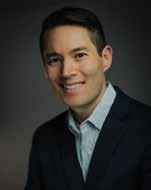
entertainment clients brandon has studied at csu fullerton, university of cincinnati college- conservatory of music, berklee college of music, and the university of southern california in his sPare time, brandon volunteers as a court aPPointed sPecial advocate (casa ) for abused and neglected children in the foster system and is an arts commissioner for the city of moorPark.
Atthe time I’m writing this Top Five article, we are in the middle of Women’s History month. It feels only appropriate to highlight five works by composers who identify as women. Some of these works are more appropriate and accessible for community choruses while others can be a great challenge for more advanced or professional ensembles.
It’s a Long Way SATB and piano www.graphitepublishing.com/product/ its-a-long-way/
Something about the poetry makes this piece fit into almost any program theme. The piano accompaniment provides support to the chorus while also allowing your collaborative pianist to shine. The piece is beautifully expressive despite its simplicity. This piece is especially recommended for developing community choirs still emerging from the pandemic crisis.
Discovery
SATB divisi a cappella musicspoke.com/downloads/discovery/
A lovely piece for professional choruses or advanced community choruses, “Discovery” is about finding renewal and strength amidst the beauty of the natural world. In the words of the composer, “the words speak to anyone who has sought answers to life’s questions while out in nature.” The musical development leading up to the words “Sun, discover us again” is absolutely stunning.
The Dawn’s Awake SATB and piano accompaniment laurenlynnmusic.com/music/
A truly vibrant piece! The opening is captivating, the middle section features a lovely contrast with a lulling piano accompaniment, and the slow build to the ending could make this piece excellent for closing a program or set. Commissioned for the 2022 Nebraska
Choral Directors’ Association conference, the work would be appropriate for any SATB community or professional ensemble.
TraCy Wong
ANTARA (Between)
SATB a cappella graphitepublishing.com/product/ antara-between/
Rhythmic, propulsive, and unique harmonics make this piece really engaging for listeners and singers alike. A musical expression of being “in between,” the work offers unique contrasts. If the Malay language is intimidating, the piece comes with an audio pronunciation guide and there is also an IPA guide. The work clocks at just under 3:30 and would be an excellent concert or set opener.
Mari EsaBEl ValVErDE
Comfort and Joy
marivalverde com/compositions/choral/
A lovely slow work with a colorful piano accompaniment. The poetry by Charles Anthony Silvestri features beautifully poignant texts that covers topics of lack of shelter, care for the youngest in our communities, and the potential for children. This piece would be a lovely centerpiece for programs that address social issues in our communities.
Ask
Most orders are fulfilled within 7 days.
Our in-stock program means we can fill many large orders quickly.
Choose how you want to order:
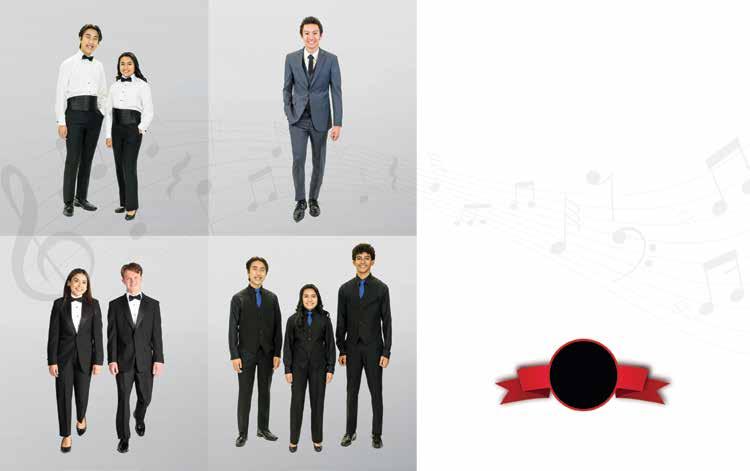
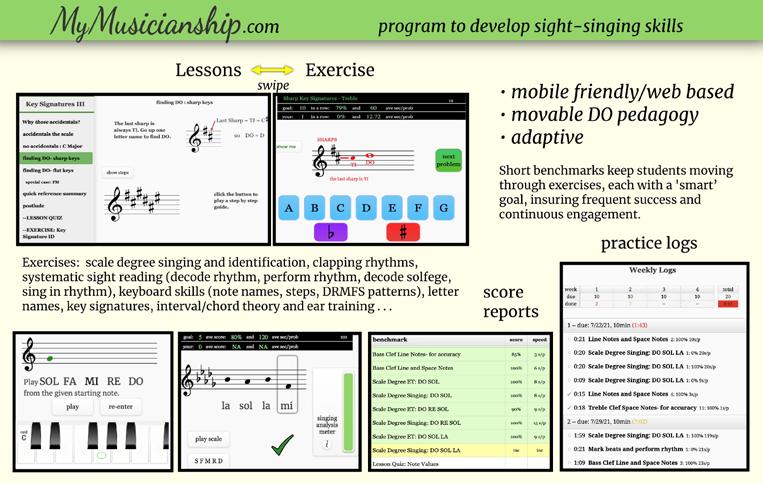
• Online
• On campus
• In-store
• Over the phone
Southern CA + Las Vegas accounts can schedule an onsite fitting or utilize our 26 locations for in-store fittings and garment try ons.
Ask about our Best Price Guarantee
FACULTY
Director of Choral Activities

Dr. Cari Earnhart
Voice
Dr Maria Briggs
Dr. Anthony P. Radford
Choral Music Education
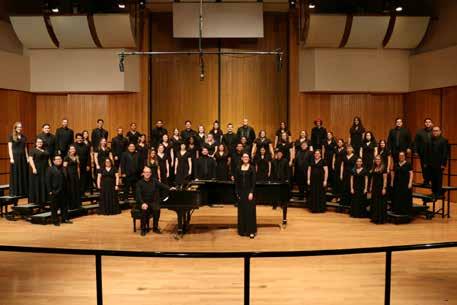
Dr Emily Mason
Dr. Tony Mowrer
Dr. Anna Hamre
Dr. Arthur Huff
Dr. Gary Unruh
Prof Helene Joseph-Weil
PERFORMANCE OPPORTUNITIES:
Dr Cari Earnhart: cearnhart@csufresno edu https://cah fresnostate edu/music/about/ensembles html

CHRiSty RoHAyEm is the director of choirs at mt eden high school. she received her bachelor ’ s degree in music education and vocal Performance from san Jose state university christy serves on the board of ccda as the chairPerson for music and worshiP and leads the committee on social Justice she has a Passion for middle eastern music and has comPleted her masters in music education from san Jose state university
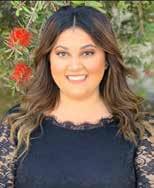
Choosing repertoire for themed seasonal concerts is oftentimes difficult. I try to keep a list of pieces that would fit any program during any season. The following selections are fantastic works that always work.
roBErT loWry, arr. JaCE kaholokula saplan
Nu’oli
SATB
Earthsongs
Dr. Saplan’s a cappella arrangement of Nu’oli is for SATB choir with divisi in the bass, tenor, and alto lines. “Nu’oli” is a Hawaiian translation of the hymn “Glad Tidings.” The sopranos hold the melody for the entirety of the piece, leaving the harmonic and rhythmic intricacies to the other lines. I particularly enjoy Saplan’s explanation of the impact that colonization has had on Hawaiian music and culture. This is a great piece for a larger ensemble but is absolutely attainable for a solid chamber group.
Joan szyMko
Arise, My Love SA
Santa Barbara Music Publishing
This is one of my all-time favorites. Syzmko writes beautifully for the voice, and this arrangement is a great middle ground in terms of difficulty level. There is occasional divisi, usually written in octaves. The text is a mash-up of the “Song of Solomon” and the hymn “At The River.” The piano accompaniment is the most challenging part of this piece, so you’re going to need a great accompanist. It is an SA arrangement that I believe would also work well for a TB choir.
rosEphanyE poWEll, arr. WilliaM C. poWEll
Non Nobis, Domine
SAB
Fred Bock Music
This a cappella SAB arrangement is a great option if you are low on tenors and basses. The bass line is written in a range
that is accessible to both bass and tenor voices, with some optional octave divisi in the middle section. The lines are repetitive and constructed from the bottom up, starting with a solo bass line. The layering effect is impressive to an audience, but it’s also a great built-in teaching tool. “Non Nobis, Domine” is also available in SATB, SSAA, and TTBB voicings.
B.E. Boykin
Stardust
SSA
Graphite Publishing
“Stardust” is a setting of text written by Brittny Ray Crowell, honoring the lives of Ahmaud Arbery, George Floyd, Breonna Taylor, and the victims of the Mother Emanuel AME Church shooting in Charleston. The vocal lines beautifully depict and uplift the text. It is written for SSA choir, piano, and djembe. The opening section is in unison and opens up harmonically and texturally as the piece progresses. Boykin’s arrangement of Crowell’s text is captivating from both a performer and audience stand point. This piece is expertly written for just about any level.
pärT uusBErg
Muusika
SATB
Walton Music
“Muusika” is a gorgeous a cappella piece written for SATB choir with minimal divisi in all vocal lines. The text depicts the beauty of the earth through the concept of harmony, musically and spiritually. The ranges of the vocal lines are quite minimal, creating a cluster effect throughout the piece. While the individual lines are quite singable, the challenge lies in the sum of all parts. Uusberg creates an atmosphere through the music that clearly expresses the heart of the poem, written by Juhan Liiv: “Somewhere, immortality endures, and the original harmony will be found. How else could it have formed in human hearts—music?”
President
Chris Peterson (562) 453-9851
cpeterson@fullerton.edu
President-Elect
Arlie Langager (858) 774-0412 alangager@miracosta.edu
Vice President
Jeffrey Benson (408) 924-4645
jeffrey s benson@gmail com
Development & VFTF
Lori Marie Rios lmrdiva1@gmail.com
Daniel Afonso dafonso@csustan.edu
Kristina Nakagawa (408) 205-6050 artistic@ resoundingachord org
Treasurer
Jenny Bent (707) 664-3925
bentje@sonoma edu
Membership
Molly Peters (213) 880-7597
mepeters79@gmail com
Summer Conference at ECCO
Alissa Aune sorcerermusic@gmail.com
CCDA State Conference at CASMEC
Angel Vázquez-Ramos avazquezramos@csub edu
CLA Coordinator
John Sorber (559) 303-9961
johnso@cos edu
Executive Administrator
Kathleen Preston 921 N. Harbor Blvd., #412 La Habra, CA 90631-3103 exec admin@calcda.org
Bay Area
Kristina Nakagawa (408) 205-6050 artistic@ resoundingachord.org
Central Jennifer Garrett jennifer.garrett@ bakersfieldcollege.edu
Central Coast Scott Glysson sglysson@calpoly.edu
Far South Yewon Lee yewonlee98@gmail.com
Northern Andrew Kreckmann (973) 903-0466
a.kreckmann@csus.edu
Southern Tina Glander Peterson (562) 453-9681
tgpeterson@me com
All-State Honor Choirs
Angelina Fitzhugh (650) 387-6730
afitzhugh@pausd.org
Susie Martone (415) 735-0910
susie.martone@gmail.com
Children’s & Community Youth
La Nell Martin (510) 350-6639 lanellmartin7@gmail.com
Junior High & Middle School
Emelynn Montoya emcollado5@gmail com
Senior High School
Stacey Kikkawa (714) 626-3984 skikkawa@fjuhsd.org
Community College Kellori Dower drkellori@gmail com
College & University Corie Brown (541) 743-6335 corie.brown@sjsu.edu
Student Activities
Alan Garcia garcia al@auhsd.us
Choral Composition
Zanaida Robles znrobles@gmail.com
Community & Professional Choirs
Brandon Elliott belliott@vcccd edu
Cantate Editor
Eliza Rubenstein cantate.editor@ gmail.com
Webmaster & Graphic Design
Josh Small webmaster@calcda.org
Ethnic & Multicultural Perspectives
Anthony Arnold (408) 799-5867
arnold anthony@cusdk8.org
LGBTQ Perspectives
Josh Palkki (202) 679-3350
josh.palkki@csulb.edu
Music in Worship
Christy Rohayem (510) 908-3047
crohayem@gmail com
Pop & A Cappella Anabel Pauline apauline2@ggusd.us
SSAA Choirs
Lauren Diez (714) 904-1035 laurendiez415@gmail.com
TTBB Choirs
Albee Mabeza amabeza@prioryca org
Vocal Jazz Andreas Preponis apreponis@fullerton.edu
Social Media Coordinator
Jason Pano (408) 768-0733
jasonpano@yahoo.com
A balance of art and academics, culture and community, exploration and excellence. Explore the possibilities at SDSU.
Undergraduate: BM Music Education, BM Vocal Performance
Graduate: MM Choral Conducting, MM Vocal Performance, Graduate Artist Diploma
music.sdsu.edu
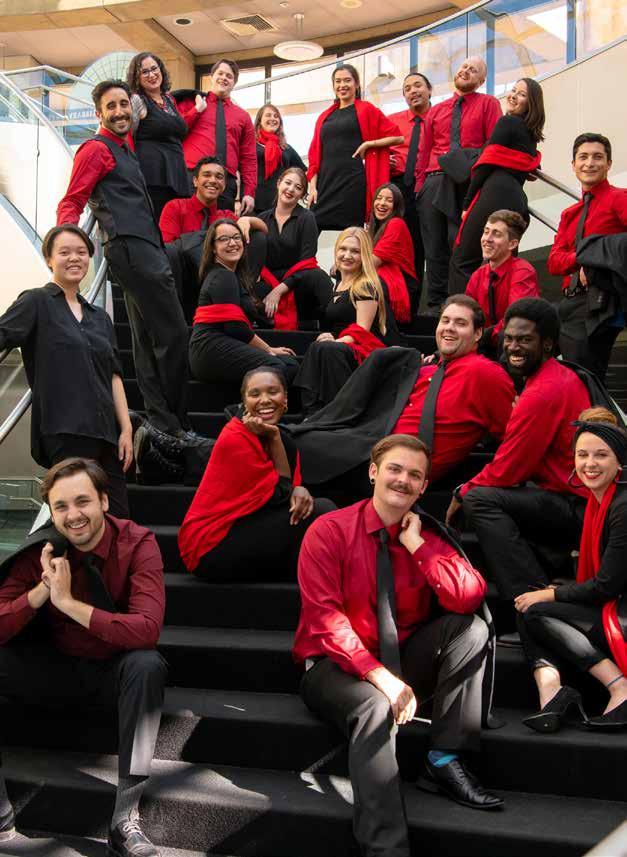
California Choral Directors Association


921 N. Harbor Blvd., #412
La Habra, CA 90631-3103
“What drew me to the MM in Choral Conducting at the Bob Cole Conservatory of Music was CSULB’s history of excellence. What ultimately cemented my decision to attend was a one-of-a kind education. I have had the opportunity to lead and sing with the internationally renowned Bob Cole Chamber Choir, rehearse and prepare my own ensembles, and receive weekly conducting lessons on some of the greatest masterworks in the repertoire. Faculty have worked to support and advance my career, pushed me to achieve feats I didn’t think possible, and showed me how to create an artistic space that is both musically excellent and rooted in a deep love of ensemble music-making. That being said, the most incredible part of the conservatory is the students. They are world-class musicians, the kindest and most supportive ensemble members, and agents of change for the future. If asked to do it all over again, I would still, and always will, pick the Bob Cole Conservatory of Music.”
—Michael McKenzie, MM Class of 2023For more information about the MM in Choral Conducting, please contact Dr. Jonathan Talberg, Frank Pooler Professor of Choral Music and Director of Choral Studies at jonathan.talberg@csulb.edu